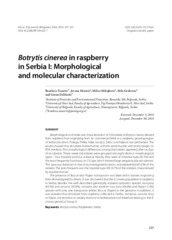Botrytis cinerea in raspberry in Serbia I: Morphological and molecular characterization
Botrytis cinerea na malini u Srbiji I: Morfološka i molekularna karakterizacija
| dc.contributor.author | Tanovic, Brankica | |
| dc.contributor.author | Hrustic, Jovana | |
| dc.contributor.author | Mihajlovic, Milica | |
| dc.contributor.author | Grahovac, Mila | |
| dc.contributor.author | Delibasic, Goran | |
| dc.date.accessioned | 2015-11-08T19:48:34Z | |
| dc.date.available | 2015-11-08T19:48:34Z | |
| dc.identifier.uri | http://arhiva.nara.ac.rs/handle/123456789/1506 | |
| dc.description.abstract | Morphological and molecular characterisation of 130 isolates of Botrytis cinerea, derived from raspberry fruit originating from six commercial fields in a raspberry growing region of Serbia (locations: Požega, Prilike, Arilje, Ivanjica, Šabac and Valjevo) was performed. The results showed that all isolates formed white, uniform, aerial mycelia with entire margin on PDA medium. First morphological differences among the isolates appeared after six days of incubation. Three-week old isolates were grouped into eight distinct morphological types – four mycelial and four sclerotial. Mostly, they were of sclerotial type (81.5%) and the most frequently found was an S3 type, which formed large irregularly placed sclerotia. This type was dominant in five of six investigated locations and represented 45-65% of the isolates. The least frequent was the mycelial type M3 (0.7% of the isolates) characterized by mycelial masses. The presence of Boty and/or Flipper transposons was detected in isolates originating from all investigated locations. It was discovered that the B. cinerea population in raspberry in Serbia, besides the well-described genetically isolated sympatric species transposa (43.1%) and vacuma (10.8%), contains also another two, boty (44.6%) and flipper (1.5%) species with only one transposon (either Boty or Flipper) in the genome. In addition, it was revealed that all isolates from raspberry collected in Serbia, transposa, vacuma, boty or flipper, are sensitive or weakly resistant to fenhexamid and therefore belong to the B. cinerea genetical Group II. | en |
| dc.description.abstract | U radu su predstavljeni rezultati morfološke i molekularne karakterizacije 130 izolata Botrytis cinerea, dobijenih iz obolelih plodova maline poreklom sa šest lokaliteta iz područja komercijalnog gajenja maline u Srbiji (Požega, Prilike, Arilje, Ivanjica, Šabac i Valjevo). Utvrđeno je da u početnim fazama razvoja na KDA podlozi svi izolati B. cinerea formiraju belu, uniformnu, rastresitu, vazdušnu miceliju ravnog oboda. Razlike među izolatima počinju da se javljaju posle inkubacije od šest dana. Na osnovu izgleda kolonije tri nedelje od zasejavanja, izolati su razvrstani u osam morfoloških tipova – četiri micelijska i četiri sklerocijska. Većina izolata je formirala kolonije sklerocijskog tipa (81,5%), a najzastupljeniji je bio tip S3 sa krupnim, nepravilno raspoređenim sklerocijama, koji je dominirao u pet od šest proučavanih populacija patogena i predstavljao 45-65% izolata. Najređi je bio micelijski tip M3 (0,7% izolata) koji se odlikuje nakupinama vazdušne micelije. Prisustvo transpozona Boty i/ili Flipper otkriveno je u genomu izolata sa svih lokaliteta. Utvrđeno je da u populaciji patogena na malini u Srbiji, osim genetički izolovanih subpopulacija transposa (43,1%) i vacuma (10,8%), postoje još dve – boty (44,6%) i flipper (1,5%) sa izolatima koji sadrže samo jednu vrstu transpozona u genomu. Istraživanje je takođe pokazalo da su svi izolati B. cinerea na malini u Srbiji, bilo da su transposa, vacuma, boty ili flipper, osetljivi ili slabo rezistentni na fenheksamid i da, prema tome, pripadaju genetičkoj Grupi II B. cinerea. | sr |
| dc.subject | Botrytis cinerea | sr |
| dc.subject | Raspberries | en |
| dc.subject | Serbia | sr |
| dc.subject | malina | sr |
| dc.subject | Srbija | sr |
| dc.title | Botrytis cinerea in raspberry in Serbia I: Morphological and molecular characterization | en |
| dc.title.alternative | Botrytis cinerea na malini u Srbiji I: Morfološka i molekularna karakterizacija | sr |
Files in this item
This item appears in the following Collection(s)
-
VOL 29 *No.4
http://www.pesting.org.rs/2014.php



